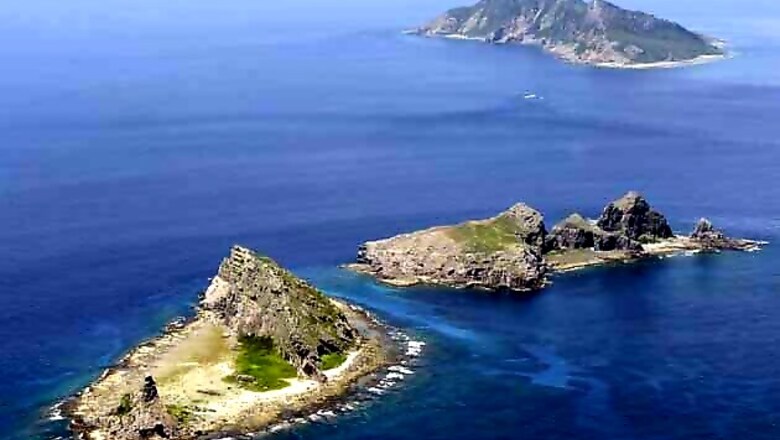
views
Two unarmed US B-52 bombers on a training mission flew over disputed islands in the East China Sea without informing Beijing while Japan's main airlines also ignored Chinese authorities when their planes passed through a new airspace defense zone on Wednesday.
The defiance from Japan and its ally the United States raises the stakes in a territorial standoff between Beijing and Tokyo over the islands and challenges China to make the next move, experts said.
China published coordinates for an East China Sea Air Defense Identification Zone over the weekend and warned it would take "defensive emergency measures" against aircraft that failed to identify themselves properly in the airspace. The zone is about two thirds the size of Britain.
"If the United States conducts two or three more flights like this, China will be forced to respond. If China can only respond verbally it would be humiliating," said Sun Zhe, a professor at the Center for US-China Relations at Tsinghua University in Beijing.
"The concept of the paper tiger is very important. All sides face it. Japan and the United States don't want to be forced into a position where they are paper tigers. China is even less eager to be a paper tiger," Sun added.
China's Defense Ministry said it had monitored the entire progress of the US bombers through the zone. A Pentagon spokesman said the planes had neither been observed nor contacted by Chinese aircraft during Monday's flight.
Following a request from the Japanese government, Japan Airlines and ANA Holdings said they stopped giving flight plans and other information to Chinese authorities on Wednesday. Neither airline had experienced any problems when passing through the zone, they added.
Japan's aviation industry association said it had concluded there was no threat to passenger safety by ignoring the Chinese demands, JAL said. Both JAL and ANA posted notices on their websites informing its passengers of their decision.
The flight by the B-52 bombers was part of a long-planned exercise, a US military official said.
Beijing may have been caught off-guard and could change its approach, said Dean Cheng, an analyst at the conservative Heritage Foundation, a Washington-based think tank.
"The fact that Washington responded and responded so strongly sends a very clear challenge back to Beijing saying: 'Look, in case you were wondering, we are serious when we say we are an ally of Japan. And do not mess with that.'"
Some experts have said the Chinese move was aimed at chipping away at Tokyo's claim to administrative control over the area, including the tiny uninhabited islands known as the Senkaku in Japan and the Diaoyu in China.
The action might have backfired, said Brad Glosserman, executive director of the Honolulu-based Pacific Forum CSIS.
"This is confirming the darker view of China in Asia," Glosserman said. "The Chinese once again are proving to be their own worst enemy ... driving the U.S. closer to Japan and (South) Korea closer to the position of Tokyo as well."
BIDEN VISITS REGION NEXT WEEK
The Chinese action was also likely to bolster support in Japan for hawkish Prime Minister Shinzo Abe's agenda to strengthen the military and loosen the limits of the post-war, pacifist constitution on its armed forces.
While Washington does not take a position on sovereignty over the islands, it recognizes that Tokyo has administrative control over them and it is therefore bound by treaty to defend Japan in the event of an armed conflict.
The B-52s, part of the Air Force fleet for more than half a century, are relatively slow compared with today's fighter jets and far easier to spot than stealth aircraft.
"We have conducted operations in the area of the Senkakus. We have continued to follow our normal procedures, which include not filing flight plans, not radioing ahead and not registering our frequencies," Pentagon spokesman Colonel Steve Warren said.
China's Defense Ministry said it had monitored the bombers.
"The Chinese side has the ability to effectively manage and control the relevant airspace," it said in a statement.
The dispute has flared before a planned trip to the region by Vice-President Joe Biden, who is scheduled to travel to Japan next week and also has stops in China and South Korea.
Annual US-Japan naval exercises are also taking place in waters off the Japanese islands of Okinawa and Kyushu, to the east of China's new zone. The drills, which involve the USS George Washington aircraft carrier, were planned before China's announcement of the zone.
CHINA DEMANDS FLIGHT PLANS
The new Chinese rules mean aircraft have to report flight plans to China, maintain radio contact and reply promptly to identification inquiries and bear clear markings of their nationality and registration.
On Monday, civil aviation officials from Hong Kong and Taiwan said their carriers entering the zone must file flight plans. A transport ministry official in Seoul said South Korean planes would do the same.
Qantas Airways Ltd said on Wednesday its pilots would keep China informed of their flights through the area.
The United States and Japan have sharply criticized China's airspace declaration, prompting Beijing to lodge counter protests and warn Washington to stay out of the dispute.
An outspoken retired Chinese military figure, former Major General Luo Yuan, wrote on Tuesday that China should use force in the zone if needed, adding the United States especially had to comply or face the consequences. Some experts, however, questioned whether China had the military assets to fully implement the new measures.
While the zone is outside China's territorial airspace, the Chinese Defense Ministry has said its establishment had a sound legal basis and accorded with common international practices.
Other countries including the United States, Japan and South Korea have similar zones but only require aircraft to file flight plans and identify themselves if those planes intend to pass through national airspace.
In addition, China sent its sole aircraft carrier on a training mission for the first time into the oil- and gas-rich South China Sea on Tuesday.
China claims almost the entire South China Sea, conflicting with claims from Taiwan, Malaysia, Brunei, the Philippines and Vietnam.
















Comments
0 comment